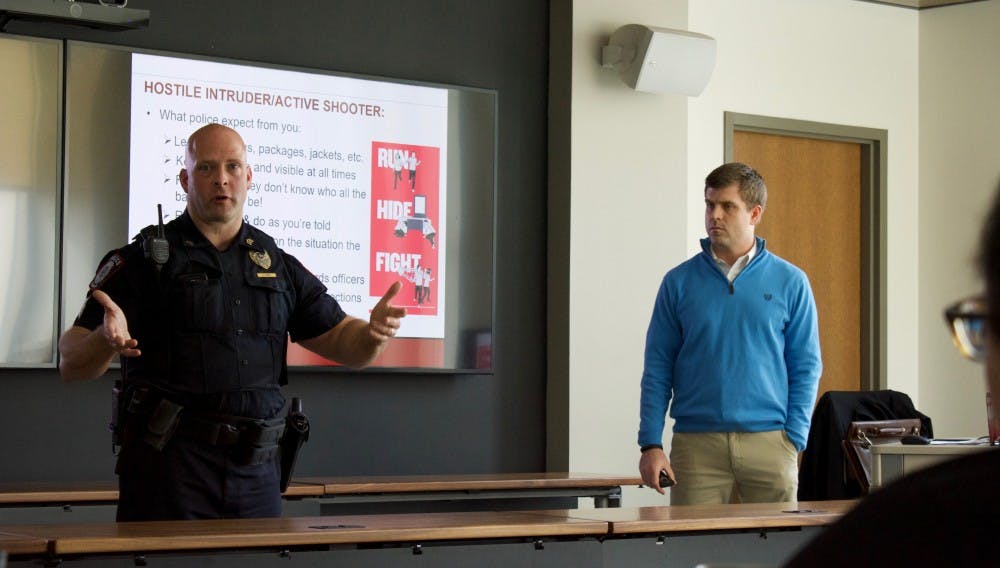Looking around the room, IU Police Department Sgt. Brian Oliger asked the people what they would do if there were a shooter outside the door. No one responded.
“Break the window,” he said. “Start thinking outside the box.”
Since the school shooting in Parkland, Florida, that killed 17 people on Feb. 14, Oliger said he has been asked to teach more active aggressor training courses than usual.
Steve Balko, assistant director of emergency management and continuity at IUB, said the class he taught with Oliger on March 8 was the fourth the pair has taught this week.
The course is available upon request, and Oliger and Balko went to the School of Public and Environmental Affairs on March 8 to do their presentation upon request by SPEA's academic coordinators.
SPEA professor Kosali Simon said active shooter situations have been on her mind since the Parkland shooting.
“I’ve been thinking about how this could happen anywhere,” she said.
Some faculty who attended the session said they had concerns about their role in helping students in an active shooter situation and worried about gray areas.
Oliger and Balko said educators have an obligation to tell students what’s going on. What happens next is up to the students.
Balko said there are a few things faculty can do to prepare for potential threat situations, including saving the IUPD dispatch number in their phones, thinking about escape routes and locating hiding places.
Oliger asked how many faculty had first aid kits in their rooms. Almost none did.
“That’s something for department heads to work on,” Balko said. “Get first aid kits.”
The class is important because active aggressor training should be as ingrained in the University’s mindset as fire drills, Balko said.
The last time a large number of students were harmed in a fire was in the 1950s, Oliger said.
The last time a student was harmed by a shooter was Wednesday.
According to FBI statistics, there were 220 active shooting incidents between 2000 and 2016. 661 people were killed in these attacks, which averages to 41 active shooter-related deaths per year.
Most of these shootings happened at businesses, but nearly 22 percent took place in educational settings. Nearly seven percent were at institutions of higher education.
“Guns aren’t going away anytime soon,” Oliger said, shaking his head. “Guns are not going away.”
At the start of the class, Balko and Oliger showed a video made by Protect IU. The video showed a reenactment of a potential active shooting situation on IU’s campus.
The video and class both recommended the “Run-Hide-Fight” approach to shooter situations. The commands are listed in order of preference, Balko said. It is ideal to be able to run or hide, but fighting is always an option.
“Try to get as many police officers and vehicles with flashing lights between you and the building as possible,” Oliger said.
Balko said a lot of doors on campus don’t lock, so students and faculty should barricade themselves into rooms if they’re trying to hide. He recommended using belts or cables to secure doors shut.
Oliger and Balko said barricades and other diversion tactics are about buying time. It would take IUPD about two minutes to get anywhere on campus, Oliger said.
Oliger said it's important to act quickly and decisively in an active shooter situation.
“Pull that inner animal out,” he said.
The same goes for fighting — the goal is to buy time until police arrive. Oliger said anything can be a weapon in a situation like that, holding up a pen.
“My personal favorite: fire extinguisher,” Balko said.
Oliger said a commonly-overlooked piece of advice is to silence cell phones during an emergency situation involving an aggressor.
If everyone in a room has IU-Notify emergency notifications enabled, even having cell phones on vibrate could make enough noise to alert an attacker to a location, he said.
Balko and Oliger will continue to teach classes about active aggressor training upon request.
Everyone at the University is encouraged to contribute to what Balko calls a culture of safety.
“We can’t predict the next threat,” he said.




